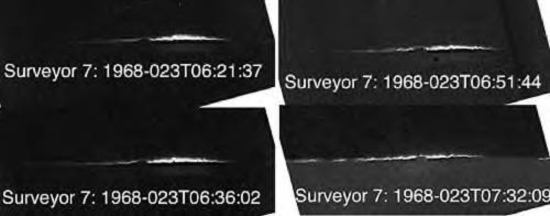
Strange glow on the lunar horizon. Credit: NASA/Surveyor 7
Nov 30, 2012
Static electric charge might help to explain the glowing haze sometimes seen rising 100 kilometers above the Moon’s horizon.
Between May 1966 and January 1968, NASA launched the Surveyor missions to the Moon. Each Surveyor spacecraft weighed approximately 450 kilograms and was designed to soft-land on the lunar surface, riding the tip of a retrorocket descent engine. Surveyor 7 made the most intriguing discovery when its onboard camera detected a faint glow in the lunar night, hovering over the horizon.
In 1998, the Lunar Prospector was launched from Cape Canaveral with gamma-ray spectrometer, alpha particle spectrometer, neutron spectrometer, magnetometer and electron reflectometer instrumentation. During several orbits, the spacecraft detected a surprisingly high voltage change as it passed through the magnetotail extending outward from Earth. The magnetotail is actually a part of the plasma sheath that envelops our planet. The Moon passes through it once a month during full moon phase; the electric differential was found to occur during that passage.
Earth is surrounded by a magnetic field that stretches well beyond the Moon’s orbit. It is elongated away from the Sun because the ion stream that emanates from our primary repels the charged plasma within the magnetotail, forming a tadpole-shaped, magnetic shell in space.
The movement of the Moon through the ionized plasma affects materials in the lunar regolith. Electrons accumulate, producing a negative charge on the ultra-fine dust particles, causing them to repel each other and drift off the surface.
Charge differential between the day and night side of the Moon might generate an ion “wind” flowing from the negatively charged night side into the more positively charged sunlit side. The negative charge on the bright surface during daylight is moderated by the photoelectric phenomenon, while it tends to build up in the darkness, forming static electricity. The charge variation between the two hemispheres has been measured at more than 1000 volts.
Earth’s plasma sheet changes shape and power as electric currents from the Sun bombard our planet. It is sometimes described as a “flag waving” because of somewhat regular oscillations in the field. This means that the Moon does not simply pass through the magnetotail once and briefly, but that electric charges will brush the surface several times during each monthly encounter.
Electric currents exist in space and their effects are varied, depending on the environment. The levitating dust and the faint glow on the lunar horizon are most likely because the Moon has no atmosphere at all, so the electric charges have greater impetus.
Stephen Smith












